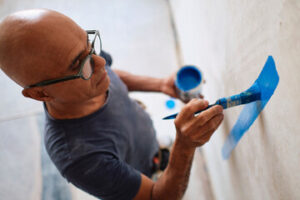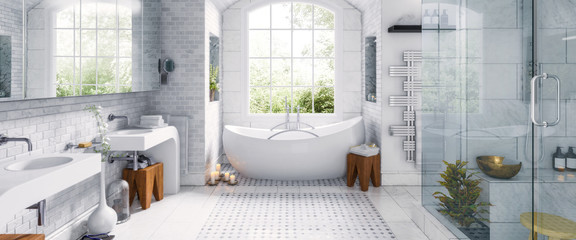Residential painting involves priming and painting walls, ceilings, floors, and other surfaces within a homeowner’s home. It is a job often done by professional painting contractors.
Painters specializing in residential painting typically work with materials and equipment similar to those at your local hardware store. That includes paintbrushes, rollers, painting trays, step ladders, and cleaning materials.

Wall paint plays a critical role in the design and style of your home. It not only enhances the appearance of a room but also protects surfaces from moisture and other contaminants. Different types of paint come in varying finishes and textures that suit the kind of walls they’re used for. There are many other uses for paint aside from the obvious cosmetic benefits. For example, bituminous paints are good for concrete and brick walls as they add a waterproof layer to these materials and are resistant to rust. These paints are durable and odor-free.
There are two overarching categories of interior paint: oil-based and water-based. Oil-based paints are typically derived from petroleum or animal products, while water-based paints use different agents to create their characteristics. Typically, the main components of a stain are pigments, resins, solvents, and additives. Pigments provide the color, resins are a binding agent, and solvents evaporate as the paint dries to leave behind the desired finish. Different additives can offer specific performance qualities like mold-killing properties.
Oil-based paints have the best coverage and durability but require more coats to cover surfaces fully and are difficult to clean. They also emit high levels of volatile organic compounds (VOCs), which can cause health problems, especially in poorly ventilated areas.
Water-based latex paints are a popular option for homeowners because they are easy to apply and clean up, dry quickly, and are less expensive than oil-based paint. They’re also available in various finishes to suit the rooms they’re used in, from matte to satin.
Residential paint is a type of coating that is used to protect and decorate interior and exterior surfaces. It is available in various colors and can create different effects. It can also be used to hide surface damage and applied to wood, drywall, metal, brick, and more. Residential painting requires many supplies, including brushes, rollers, and masking tape. Masking tape is essential to protect areas that do not need an image and can be used to cover door sills, window trim, and more. Painting trays are necessary for holding and pouring paint, and they come in various sizes to suit different projects. Brushes are also an important part of the painting process and come in natural and synthetic materials, with multiple shapes and sizes for other finishes.
Regarding home improvement, painting is a small and superficial addition. However, a fresh coat of paint can dramatically change a room’s look and feel, increasing the value of a home. In addition, painting can help to make a home more energy-efficient and comfortable for the residents.
Whether you are looking to sell your house or want to update the look of your home, hiring a professional painter is always a good idea. These experts have the tools and experience to complete the job quickly and efficiently without sacrificing quality. They will use high-quality paints and other products that will last long.
While it is possible to do a home painting project yourself, it can be difficult and time-consuming. It can also be expensive, as you must buy many supplies and equipment. That can include a variety of tools, such as a ladder, step stool ladder combination, drop cloths, and plastic sheeting. You will also need to purchase paint and other materials, which can add up quickly. That can be avoided by hiring a professional painter with the necessary equipment to properly calculate to ensure you buy the right amount of paint.
Residential painting focuses on the interior and exterior walls of homes, condos, apartments, and other living spaces. It involves various wall types and finishes, from matte and eggshell to high-gloss. The main goal of residential painting is to make a room look attractive and welcoming. It also helps to protect surfaces from damage and wear.
While a homeowner can do the painting themselves, hiring professionals for this task is best. Professionals have experience working with homeowners to ensure that the job is completed as expected. They can also advise on the type of paint that is best for a particular surface. In addition, they can help with the preparation process to ensure that the color is applied properly.
During the prep stage, it is a good idea to remove all breakable items from the area that is being painted. That can include pictures, mirrors, and other decorations. Taking them down will save the painters time and hassle and prevent them from accidentally ruining them with paint splatters. It is also a good idea to take down curtains and other window treatments so that they do not get in the way of the painting crews.
It is also a good idea to cover furniture and other items that cannot be removed from the area with drop cloths or plastic sheeting. That will keep them from getting covered in dust and debris. Protecting any shrubs or flower beds in the area is also a good idea so they are not sprayed with paint. Lastly, finding a friend or family member to watch any pets during the painting project is a good idea.
Painting can be messy work. It doesn’t matter whether you are a professional painter or a homeowner taking on the task yourself; there will be some spills and drips that need to be cleaned up. Have clean rags on hand to quickly wipe away any paint that gets on the floor or other surfaces around the house. Oil-based stains require a solvent or a mechanic’s hand cleaner, while latex-based paints can be easily cleaned with water.
Proper cleaning up is an important step many residential painters take to prevent property damage from their painting activities. They will often cover carpeting and drapes with tarps to minimize the chances of splatters damaging these items. In addition, they will thoroughly dry all areas where they have worked to reduce the possibility of future staining or cracking. This extra effort ensures customers get the best results from their residential painting project. That is one of the reasons that homeowners often prefer to hire a professional painter for their projects. These contractors are experienced in handling all aspects of painting projects, including planning, prep, and clean-up.
Residential painting projects can pose several safety risks. Using chemicals that may cause skin or eye irritation, working at elevated heights, and improperly handling equipment like ladders can all be hazards for residential painters. In addition, if not properly cleaned up, paint and other materials can cause fire hazards within the building. Taking the right steps to minimize these dangers can ensure that all individuals inside the building are safe throughout a painting project.
Paintbrushes, rags, and other painting supplies may not seem dangerous at first glance but can quickly turn into weapons. A wildly swinging brush can easily leave a splotch of paint in someone’s eyes, and improperly secured ladders can send people plummeting to the ground from multiple stories high. Dust and other debris can also become airborne when preparing surfaces for painting. These particles can lead to respiratory problems for anyone who breathes them and must be kept away from children and pets. Lastly, if a room isn’t properly ventilated during the painting process, harmful vapors can build up and cause dizziness, nausea, or even a loss of consciousness for some.
Painting contractors can reduce the risk of these hazards by establishing proper safety procedures and training their field crews to follow them. A system such as SupplyPro GM for Painters can help by providing mobile safety checklists that field crews can use to record their compliance with the company’s safety plan on every job site.
Taking precautionary measures is important to keep people and property safe during a painting project. While this is often a quick and simple task, it’s always best to be safe rather than sorry. It’s especially important to follow good housekeeping, ensuring all cords and other hazards are properly out of the way and removing clutter from working areas and walking paths.


 Cost
Cost